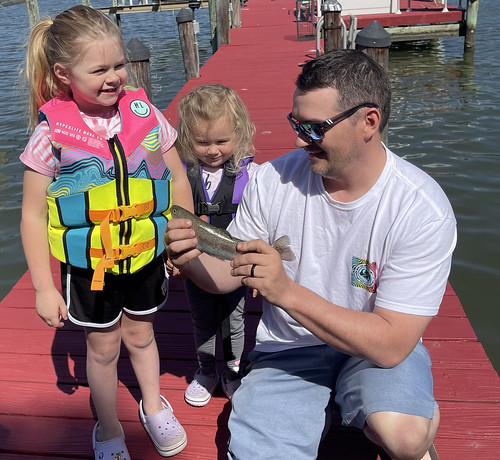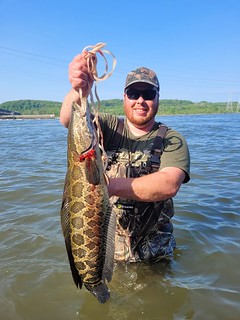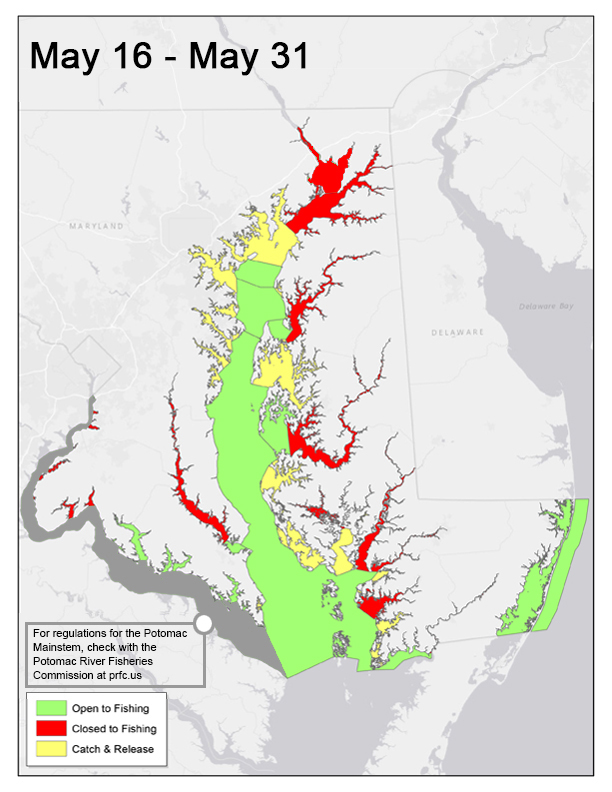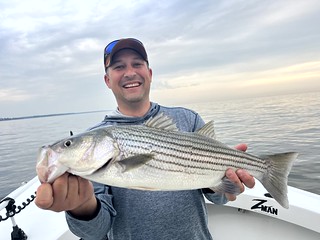Maryland Fishing Report – May 24

Young angler Olivia Frantz (left) caught this rainbow trout on a day out with her sister Emily and their dad, Ricky. Photo by Kimberly Sizemore
Memorial Day weekend is a time to celebrate with family gatherings and also to reflect on those who gave all to protect the freedoms we enjoy. Fishing offers the time to do both – and this weekend is a perfect opportunity to take your youngsters out and collect some memories and smiles.
Maryland will host the first of three license-free fishing days June 3. During a free fishing day, a person may catch and possess finfish in the tidal and nontidal waters of Maryland for recreational purposes without an angler’s license, Chesapeake Bay sportfishing license, or any fishing stamp normally required by the Department of Natural Resources. All other fishing laws and regulations will apply on those days. Maryland’s free fishing days are the first two Saturdays in June and on the Fourth of July.
Forecast Summary: May 24 – May 30:
Continued warm weather in the upcoming week will keep water temperatures rising for Chesapeake Bay gamefish. Main Bay surface water temperatures have risen since last week to the upper 60s.
Bay salinity is still above average. Some areas of low oxygen are present in the bottom waters in the main Bay and Potomac River, from Swan Point down to the mouth of the river, and from Colonial Beach to Breton Bay. However, there are still plenty of cool, well oxygenated areas in the Bay to pursue gamefish.
Expect below average flows all week. There will be above average tidal currents on Wednesday and Thursday as a result of the previous new moon on May 19. Expect average water clarity in Maryland’s bay, rivers, and streams. To see the latest water clarity conditions, check Eyes on the Bay Satellite Maps.
As always, the best fishing areas could be further refined by intersecting them with underwater points, hard bottom, drop-offs, and large schools of baitfish.
For more detailed and up-to-date fishing conditions in your area of the Bay, be sure to check out Eyes on the Bay’s Click Before You Cast.

Brett Wilt recently caught this large northern snakehead on the Susquehanna Flats. Photo courtesy of Brett Wilt
Anglers are enjoying some spectacular fishing for northern snakeheads in the Conowingo Dam pool and just below. The dam is the end of the road for snakeheads migrating up the Susquehanna River and they tend to pile up there. Casting white paddletails tends to be the most popular way to fish for them but they will strike other lures. Fishing for flathead catfish in the dam pool has also been good; fresh cut gizzard shad or with live bait small live white perch and bluegill sunfish are good baits.
The Susquehanna River is open to striped bass fishing with a slot of 19 inches to 26 inches and one fish per day per angler. Most anglers are jigging with soft plastic jigs or casting crankbaits, others are chunking and enjoying a mixed catch of channel and blue catfish, along with that coveted striped bass measuring within the keeper slot size.
Anglers must fish below a line drawn from the Lapidum boat ramp to Twin Rocks and to Tome’s Landing Marina in Port Deposit south to a line drawn from Sandy Point to Turkey Point. Some other areas of the upper Bay are catch-and-release only and others remain off-limits to any type of striped bass fishing, until June 1. For exact information, please check the map on the Department of Natural Resources website and a complete list of regulations for striped bass fishing in the Chesapeake Bay and its tidal tributaries.
In the portion of the upper Bay below the line from Hart-Miller Island to Tolchester, the slot size is 19-31 inches. In that area, jigging has been very popular along the steep edges of the shipping channel, the Love Point Rocks, and the Bay Bridge piers. Most anglers are using ¾-ounce jig heads and a variety of soft plastics, either skirted or not. Drifting with small live white perch or soft crab baits back to the bridge pier bases is working well for anglers targeting striped bass.
Trolling for striped bass along the channel edges is certainly a viable option for anglers this week. Trolling with umbrella and tandem rigs is a good way to cover plenty of water along the shipping channel edges. Depending how deep the fish are suspended, it may take significant weight to get down to where the fish are holding. Medium-sized bucktails dressed with sassy shads are popular, Storm shads are a good choice and spoons work well also. When fishing with spoons and shads, the drag may be minor enough that planers can be used.
White perch are being found in the lower sections of the region’s tidal creeks and rivers this week and providing excellent fishing opportunities. Many anglers are using bait in the form of grass shrimp, live minnows, or bloodworms or casting small jigs and spinners along shoreline structure.
Blue catfish can be found throughout the upper Bay and in every tidal river, the Susquehanna and Chester rivers hold some of the largest populations. At times they will also be mixed with channel catfish. Fresh cut bait tends to be popular – menhaden, gizzard shad, white perch, and bluegills will all fit the bill; chicken liver, shrimp, and nightcrawlers will work well also. An increasing number of anglers are now jigging along channel edges for blue catfish, and it is not uncommon for them to chase down a crankbait.
The middle Bay is providing plenty of striped bass opportunities this week. The annual spring mating ritual of clam worms, commonly called May worms, usually occurs around this time on the new moons in May and June when water temperatures are in the upper 60s. The next new moon is June 18. Anglers should keep watch if they have access to a dock light to witness the swarms. When the mating hatch occurs, the worms rise from the bottom to the surface and striped bass and white perch gorge on them. Using red or pink plastic jigs in the 5-inch size range is the ticket if a striped bass is looking for one more clam worm.
Anglers are jigging along the edges of the shipping channel this week, and the drop-off at Thomas Point is always a popular stop. The rocks on the west side of Poplar Island are a great spot to cast soft plastic jigs or paddletails in the early morning or evening hours; poppers are a fun and exciting way to get into the action. Eastern Bay is still catch-and-release till June 1 and the Choptank River is closed to all striped bass fishing above the line from Holland Point to the west entrance of Chapel Creek. Legal striped bass must measure between 19 inches and 31 inches, and the catch limit is one fish per day per angler in Maryland waters.
Trolling is a good option this week and a great way to cover a lot of water along the edges of the shipping channel and the False Channel. The shipping channel edge in front of the Gum Thickets and across the bay at Hacketts Point, the edge along Buoy 83, and out in front of Chesapeake Beach and Breezy Point are a few popular places to troll. Umbrella rigs and tandem-rigged bucktails or shads are good choices, and small red teasers on an umbrella rig is a good way to imitate a May worm swarm when their hatch takes place.
More than a few anglers are chumming or chunking for striped bass at traditional locations such as the outside edge of Hacketts, Thomas Point, and the Clay Banks. Blue catfish are not as common barging in on a chum slick this far down the Bay, but cownose rays are in abundance this week. Those jigging and trolling have been snagging them and when they’re thick, it is hard to avoid them. They are reported to be tearing up the shallow grass beds in the Kent Island area, most likely feeding on razor clams and crabs.
White perch have moved into their typical summer habitat areas and will be providing fun fishing till the fall. Docks, piers, jetties, and oyster beds are good places to look for them. The perch will usually be holding under a pier or close to it if the water is deep enough. Grass shrimp and pieces of bloodworm are the best baits to fish for them on a simple one-hook bottom rig with a half-ounce to 1-ounce weight and a No. 4 hook rigged to hold about 5 inches off the bottom. In the evenings they can be found along shoreline structure; casting small spinners, spinnerbaits, and small jigs is a fun way to fish for them with light tackle. If fly fishing, it is hard to beat a silver flash and chartreuse Clouser.
There are plenty of channel catfish to be found in the region’s tidal rivers this week, along with a blue catfish now and then. The Choptank River holds the greatest number of blue catfish. Anglers are reporting the blue catfish bite has been off this week, possibly due to their spawning. Biologists report that blue catfish will often hold close to deep structure when spawning; sunken wood often fits the bill. Please feel free to interrupt these invasives when they are spawning.
Fishing for striped bass is alive and well in the lower Bay, where there are a variety of ways to fish for them. Many are finding good opportunities for jigging along channel edges when their depth finders spot the fish suspended off the bottom; soft plastic jigs in shades of chartreuse and ¾-ounce jig heads are the most popular offering. The shipping channel edges and the edges of the main channel in the lower Potomac River are excellent places to look.
Trolling these same edges with umbrella rigs, tandem-rigged swim shads, or bucktails dressed with a sassy shad or curly tail with sufficient weight to get them down to where the fish are holding. A small spoon behind a planer can also be effective and a lot easier to reel in. The daily limit is one striped bass per person per day measuring from 19 inches to 31 inches in Maryland waters. In the tidal Potomac the daily limit is two striped bass per day per person, and the slot size is 20 inches to 31 inches.
Anglers who can get out fishing early in the morning or in the evening are being treated to some excellent shallow water fishing for striped bass along shorelines and places with structure such as the Cedar Point rocks and locations on the lower Potomac. On the eastern side of the Bay, the cuts through Hoopers Island are open to catch and release fishing and the marsh edges and creeks of Tangier Sound are open to possession of striped bass.

Anglers near Tangier Sound are enjoying good shallow-water fishing for a mix of striped bass and speckled trout. Many are either casting paddletails or drifting soft crab baits with good success.
Cownose rays have been particularly pesky in the lower Bay the past week and they can really get into the way when fishing. Snagging one while jigging or trolling is no fun and if you’re fishing with heavy braid, make sure you have a lighter mono leader so you can break them off more easily. Cownose rays have few redeeming qualities when present in such great numbers; they love chowing on blue crabs and clams and are a real pain if they pick up a soft crab bait. Bull sharks also can be troubling, but they can help control the cownose rays by eating them.
White perch can now be found in the lower sections of the region’s tidal rivers and creeks, providing fun fishing near dock piers, rocks, and oyster beds. Grass shrimp and pieces of bloodworm on a bottom rig tend to be the most popular way to fish for them when they are holding in deeper waters. In the evenings they will move into shallower water and can be caught by casting small spinners near shoreline structure. Spot are beginning to show up on traditional areas near the mouth of the Patuxent River.
Fishing for blue catfish in the region’s tidal rivers is a sure thing in most areas. There are large populations of blue catfish to be found – their population continues to expand and grow, and the catfish are getting larger.
Recreational crabbers are out in force in many tidal rivers, especially on the eastern side of the Bay. Catches have been poor to fair in most areas, with success improving the farther south one goes on the Eastern Shore. The reports from the southern waters do tell of smaller crabs, but a lot of them, which gives hope for next month. There are reports of larger crabs in the middle Bay that are paper shell and light, and it makes no sense to keep these crabs, as it will take another week or two for them to fill out. There is good news from farther up the creeks where the larger crabs are reported to be heavy. The results of the winter blue crab dredge survey were released last week and can be viewed on the Department of Natural Resources website.
Trout fishing is beginning to slow down in the central and southern regions. As we move into June, water temperatures become too warm to continue stocking trout, but there are holdovers. Exploring the previously stocked waters by casting small spinners and spoons is a great way to cover a lot of water looking for that holdover trout. The delayed harvest waters that are catch and release will be open from June 1 through September 30 with a limit of 5 trout per day.
Now that Memorial Day weekend is upon us, anglers will begin to see more boat traffic on Deep Creek Lake, so be careful out there. More floating docks are deployed, which is a good thing for largemouth and smallmouth bass anglers. Skipping wacky rigged stick worms or soft plastic under the docks is a great way to hook up with a loafing fish holding in the shade of the dock. Bluegill sunfish get quite large at Deep Creek Lake and always provide plenty of fun for anglers along the shorelines and floating docks.
This week is a great time to take our younger anglers out fishing; those that are just starting will do fine targeting various sunfish species at local community ponds with a simple bobber and worm rig. There are several youth fishing events taking place throughout the summer; check the Department of Natural Resources website to search for youth fishing rodeos.
In the many ponds, reservoirs, and tidal waters of Maryland, largemouth bass are aggressively feeding in their post-spawn modes. Water temperatures are still moderate enough that the fish are active throughout the day, especially near cover in the form of grass, spatterdock fields, lily pads, or fallen treetops. A wide variety of lures will work well – soft plastics, stick worms, spinnerbaits, jerkbaits and crankbaits are all good choices.
There are good surf fishing opportunities along the beaches of Assateague this week. Striped bass are being caught, many are large and over the 31-inch maximum, but they provide some exciting catch-and-release fishing. Red drum are beginning to be caught and most are over the maximum of 27 inches, so they also must be released.
Medium-sized black drum are still being caught now and then as are a variety of inshore sharks. Anglers are using a variety of baits including cut menhaden, sand fleas, clams, and bloodworms. Cownose rays continue to be pesky bait stealers but will keep anglers from dozing off. Kingfish should show up soon.
Fishing for school-sized striped bass is very good this week along the inlet jetties, bulkheads and the Route 50 Bridge area and coastal bay bridges. A large proportion of the striped bass fail to meet the 28-inch minimum but not by much, so eventually one will be legal sized. Bluefish can also be part of the mix. Casting soft plastic jigs tends to be the most popular way to fish although some are having good luck with paddletails near the coastal bay bridges.
Flounder fishing in the channels leading from the inlet has been good on a variety of baits. Many anglers opt for Gulp baits when targeting larger flounder. Traditional baits of minnows and squid strips will never go out of favor. The Thorofare Channel has been a standout place to drift for flounder.
The charter and party boats heading out of Ocean City are focusing on black sea bass this week and the catches are good. It is not uncommon for limit catches and some boats have reported boat limits. The daily catch limit per angler is 15 per sea bass at a minimum length of 13 inches.
“You wonder if a fish goes home and exaggerates the size of the bait it stole.” – Bob Hope
Maryland Fishing Report is written and compiled by Keith Lockwood, fisheries biologist with the Maryland Department of Natural Resources.
Click Before You Cast is written by Tidewater Ecosystem Assessment Director Tom Parham.
This report is now available on your Amazon Echo device — just ask Alexa to “open Maryland Fishing Report.”




